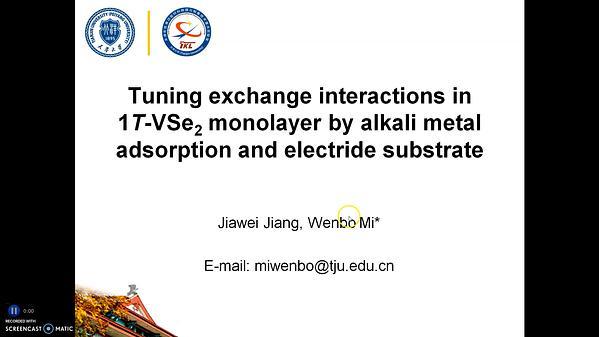Would you like to see your presentation here, made available to a global audience of researchers?
Add your own presentation or have us affordably record your next conference.
Two-dimensional van der Waals (vdW) heterostructures are at the forefront of research due to their extensive potential as a platform for spintronics and opto-spintronics applications 1. Room-temperature ferromagnetism has been achieved in several two-dimensional (2D) magnetic materials and heterostructures 2,3. Ferromagnetic 2D semiconductors are of particular interest since they allow for simple integration with current silicon-based electronics and their properties can be easily tuned with electric fields and optical excitations. Recently, we demonstrated light tunable magnetism in V-doped WS2 (V-WS2) monolayers, mediated by optically injected charge carriers 4. A similar effect was shown in ML-VSe2/BL-MoS2 heterostructures in which the magnetization of VSe2 penetrates into the non-magnetic optically active MoS2 layer, allowing for the tunability of the magnetic properties of the heterostructure with light. The VSe2 layer facilitates charge separation, which promotes changes in the magnetization of the MoS2 layer, showing an enhanced light mediated magnetism effect compared to V-WS2. We present a study of related 2D magnetic heterostructures where we compare the magneto-optical response of VSe2/MoS2, VSe2/WS2 and V-MoS2/graphene heterostructures. We propose that, as the VSe2 layer in the VSe2/MoS2 heterostructure allows for charge separation through the interface, graphene in a V-MoS2/graphene heterostructure may play a similar role. The difference between the two systems lies in the source of the magnetism of the semiconducting layer. In the VSe2/MoS2 and VSe2/WS2 systems, the ferromagnetic VSe2 layer is responsible for the proximity magnetism in the non-magnetic MoS2 layer, while in V-MoS2/graphene the semiconducting layer is magnetically doped. Moreover, V-MoS2 shows enhanced magnetic properties when interfaced with graphene, compared to samples grown on Si/SiO2 which may further influence the interaction between the optically injected charge carriers and the magnetic dopants. These findings show how the interactions between photogenerated charge carriers and 2D magnetic semiconductors can be tuned in carefully constructed vdW heterostructures.
References 1 J.F. Sierra, J. Fabian, and R.K. Kawakami, Nature Nanotechnology., Vol. 16, p. 856-868 (2021)
2 F. Zhang, A. Sebastian, D.H. Olson, Advanced Science., Vol. 7, p. 2001174 (2020)
3 M. Bonilla, S. Kolekar, Y. Ma, Nature Nanotechnology., Vol.13, p. 289-293 (2018)
4 V. Ortiz Jiménez, Y.T.H. Pham, M. Liu, Advanced Electronic Materials., Vol. 7, p. 21000310 (2021)
